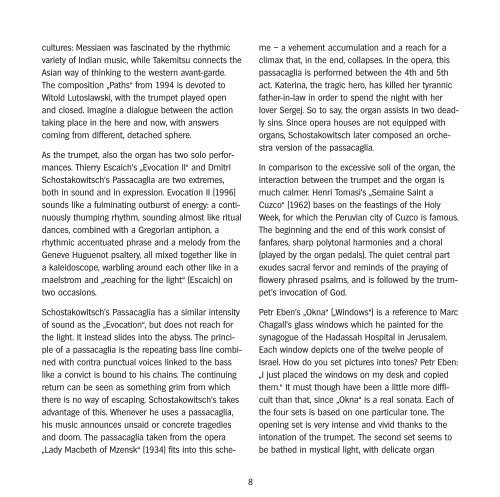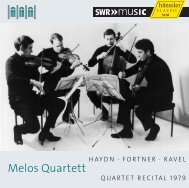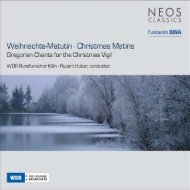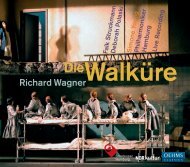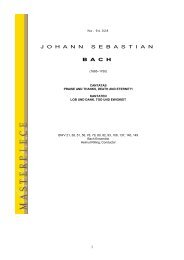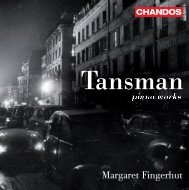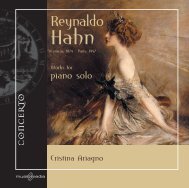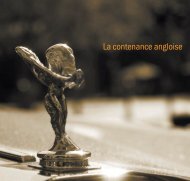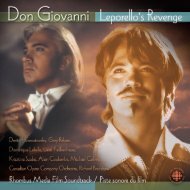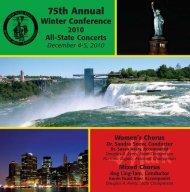TRUMPET ORGAN - Naxos Music Library
TRUMPET ORGAN - Naxos Music Library
TRUMPET ORGAN - Naxos Music Library
Erfolgreiche ePaper selbst erstellen
Machen Sie aus Ihren PDF Publikationen ein blätterbares Flipbook mit unserer einzigartigen Google optimierten e-Paper Software.
cultures: Messiaen was fascinated by the rhythmic<br />
variety of Indian music, while Takemitsu connects the<br />
Asian way of thinking to the western avant-garde.<br />
The composition „Paths“ from 1994 is devoted to<br />
Witold Lutoslawski, with the trumpet played open<br />
and closed. Imagine a dialogue between the action<br />
taking place in the here and now, with answers<br />
coming from different, detached sphere.<br />
As the trumpet, also the organ has two solo performances.<br />
Thierry Escaich’s „Evocation II“ and Dmitri<br />
Schostakowitsch’s Passacaglia are two extremes,<br />
both in sound and in expression. Evocation II (1996)<br />
sounds like a fulminating outburst of energy: a continuously<br />
thumping rhythm, sounding almost like ritual<br />
dances, combined with a Gregorian antiphon, a<br />
rhythmic accentuated phrase and a melody from the<br />
Geneve Huguenot psaltery, all mixed together like in<br />
a kaleidoscope, warbling around each other like in a<br />
maelstrom and „reaching for the light“ (Escaich) on<br />
two occasions.<br />
Schostakowitsch’s Passacaglia has a similar intensity<br />
of sound as the „Evocation“, but does not reach for<br />
the light. It instead slides into the abyss. The principle<br />
of a passacaglia is the repeating bass line combined<br />
with contra punctual voices linked to the bass<br />
like a convict is bound to his chains. The continuing<br />
return can be seen as something grim from which<br />
there is no way of escaping. Schostakowitsch’s takes<br />
advantage of this. Whenever he uses a passacaglia,<br />
his music announces unsaid or concrete tragedies<br />
and doom. The passacaglia taken from the opera<br />
„Lady Macbeth of Mzensk“ (1934) fits into this sche-<br />
8<br />
me – a vehement accumulation and a reach for a<br />
climax that, in the end, collapses. In the opera, this<br />
passacaglia is performed between the 4th and 5th<br />
act. Katerina, the tragic hero, has killed her tyrannic<br />
father-in-law in order to spend the night with her<br />
lover Sergej. So to say, the organ assists in two deadly<br />
sins. Since opera houses are not equipped with<br />
organs, Schostakowitsch later composed an orchestra<br />
version of the passacaglia.<br />
In comparison to the excessive soli of the organ, the<br />
interaction between the trumpet and the organ is<br />
much calmer. Henri Tomasi’s „Semaine Saint a<br />
Cuzco“ (1962) bases on the feastings of the Holy<br />
Week, for which the Peruvian city of Cuzco is famous.<br />
The beginning and the end of this work consist of<br />
fanfares, sharp polytonal harmonies and a choral<br />
(played by the organ pedals). The quiet central part<br />
exudes sacral fervor and reminds of the praying of<br />
flowery phrased psalms, and is followed by the trumpet’s<br />
invocation of God.<br />
Petr Eben’s „Okna“ („Windows“) is a reference to Marc<br />
Chagall’s glass windows which he painted for the<br />
synagogue of the Hadassah Hospital in Jerusalem.<br />
Each window depicts one of the twelve people of<br />
Israel. How do you set pictures into tones? Petr Eben:<br />
„I just placed the windows on my desk and copied<br />
them.“ It must though have been a little more difficult<br />
than that, since „Okna“ is a real sonata. Each of<br />
the four sets is based on one particular tone. The<br />
opening set is very intense and vivid thanks to the<br />
intonation of the trumpet. The second set seems to<br />
be bathed in mystical light, with delicate organ


